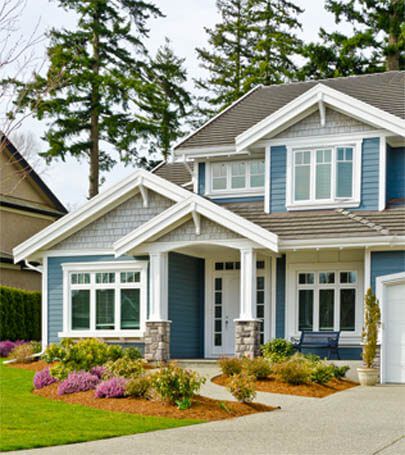The outside of your home is like any first impression; it sets the tone.
Whether it's a quick glance from a neighbor passing by, or the reaction from friends and relatives in for the weekend, those who see the outside of your home will see it as a reflection of you, your taste, and the level of pride you take in your home.
If you're looking to upgrade the appearance of the exterior of your home, there's no better place to start than your siding, and the landscaping that surrounds it. Here's a few pointers on how to help them work together to create a truly welcoming look and feel for the outside of your home.

Planting shrubbery and/or trees at near the front of your home can provide the perfect exterior enhancement, particularly in tandem with new siding. Often called "foundational planting," these plants add additional greenery and beauty, and also helps create a pleasant contrast between the dramatic, straight lines of your siding, and the softer shape of natural elements. Be aware of the size of your plantings; the usual rule of thumb is "tall at the corners, low in front." Tall plantings at the corner of your home helps soften edges (and actually makes your home appear larger), while low-profile shrubs are typically a better choice for the front of your house. Keep in mind that taller plantings can needlessly obscure views of your home and siding, and block air and light from coming through your windows.
Be sure to consider the size of your plantings when they're fully mature. Evergreens that look perfect when first planted can quickly turn into window-blockers as they mature. Selecting varieties that top out at 2 to 4 feet tall are usually the right choice for underneath your windows, and other smaller spots.
Installing a masonry surround for a tree or trees in your front yard creates a pleasant visual effect, in particular as the curves of the surround compliment the straight lines of siding and the faÇade of your home. The same applies to creating a clean, distinct edge where the lawn meets your flower beds. Both are relatively simple projects that can add instant visual interest to the exterior of your home, and as an added bonus, both make mowing the yard easier.
You might only think of the outside of your home and its landscaping in the context of being seen during the day. But the beauty of the exterior of your home and can shine brightly through the evening hours as well. Strategically placed directional lighting can accentuate both your home and the landscaping that surrounds it, and create a unified look that's both dramatic and refined.
Consider installing lights at the base of your home pointed upwards ("uplighting"), or, simply place a bright, outdoor-use spotlight in your front yard and direct it towards your home. The addition of directional light will accentuate the eye-catching shadow lines of your siding to create a strong visual effect. Adding additional lighting to illuminate select trees, shrubbery, or lawn décor will give the exterior of your home a custom look and feel.
As you evaluate your lighting preferences, also consider using accent lights to illuminate your walkway. It creates an outdoor "red carpet" feel as you approach your home, helping provide safe passage, and making the front of your home the star of the show. Pro tip: Place walkway lamps close enough together that their light overlaps, about every 3-6 feet.
Window boxes are akin to miniature gardens, and can give the exterior of your home an entirely new and invigorated look. They draw the eye to both the plants within the window box, and the windows themselves. They also create "pops" of natural beauty that accentuate the color of your siding. Pro tip: When planting within your window box, follow the "thriller, filler, spiller" recipe: a tall plant in the center, mounding plants on the sides, and trailing plants flowing over the front edge.
Once you've got the outside of your home and front yard looking the way you like, protect your hard work and help your lawn stay green. Among the biggest culprits when the lawn is brown are dull mower blades, set at an inappropriate height. While it may be tempting to set the blades low to stretch the time between each mowing, grass that is cut too short is highly susceptible to browning. Lawn experts suggest cutting no more than an inch of grass at a time to help keep your lawn looking its best.
Enjoy your refreshed home exterior, and feel free to discover more ways to help you keep your home looking its best.

